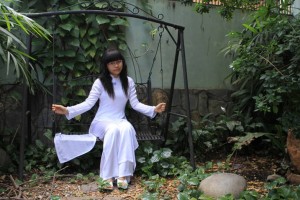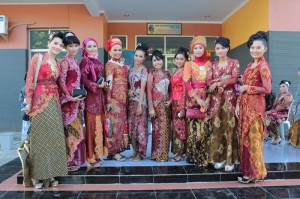National spirit revealed through costumes
by Tien Tran – Guest Writer
We know that Hesston has a strong international student presence. These students call Thailand, Korea, Japan, Vietnam, Ethiopia and many other nations home. What you may not know is that their cultural heritage, traditions, customs, and rituals are often deeply rooted in their traditional dress.
International students at Hesston College will soon have a chance to showcase these costumes at the International Festival March 26. But here’s a sneak peak: Three Asian students are providing a look at their gorgeous costumes, representing their home countries of Vietnam, Japan, and Indonesia.

Ngoc Lam, a freshman, is wearing the traditional costume of Vietnamese women, “ao dai.” Ao dai is the Vietnamese most famous dress, worn by girls and women of any age, especially on special occasions. Typical events include wedding parties, the Lunar New Year or for fashion shows. Female tourists visiting Vietnam are known to buy “ao dai” as souvenirs. In Vietnam, girls must wear “ao dai” to school as a uniform.

Irene Mine, a sophomore, wears a “kimono,” a traditional Japanese costume. Kimonos are worn by Japanese males and females on special occasions, but the kimono for women looks more complicated and fashionable in design. Japanese use thick and colorful kinds of cloth to make the kimono, which is usually made in various lively colors and creative patterns. Single girls often wear bright colored kimonos while married ladies and the older ones tend to wear dark colored kimono. It is not easy to take off the kimono because there are several separating pieces needed to be on in order that cannot be messed up. The kimono is also formally worn with a certain hairstyle seen in Irene’s photo, as well as with split-toe socks and wooden thongs.

Different from ao dai and the kimono but no less charming, Kebaya, an Indonesian traditional garment, has the most antique, classical, and formal look. Crisentia Celine Gregor, a freshman, is pictured wearing the kebaya in a teen beauty contest, in which she was awarded fifth prize. The kebaya is worn with special hairstyles, usually buns, and high heels, which can exaggerate the girls’ height. The kebaya is made from fabric such as silk or satin, which is not widely used in the United States. The dress is embroidered with abstract patterns that represent Indonesian beauty, creativity and spiritual beliefs. Sometimes the kebaya is patterned with fancy golden materials and is worn by brides in wedding parties.


